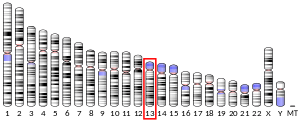LMO7
LIM domain only protein 7 is a protein that in humans is encoded by the LMO7 gene.[5][6][7]
This gene encodes a protein containing a calponin homology (CH) domain, a PDZ domain, and a LIM domain. An F-box (FBX) domain is present in alternative splice variants. Members of the LIM protein family carry the LIM domain, a unique cysteine-rich zinc-binding domain. Members of the FBX protein family are involved in protein-protein interactions. The encoded protein may be involved in protein-protein interactions. Multiple alternative splice variants have been described but their full-length sequences have not been determined.[7]
References
- 1 2 3 GRCh38: Ensembl release 89: ENSG00000136153 - Ensembl, May 2017
- 1 2 3 GRCm38: Ensembl release 89: ENSMUSG00000033060 - Ensembl, May 2017
- ↑ "Human PubMed Reference:".
- ↑ "Mouse PubMed Reference:".
- ↑ Putilina T, Jaworski C, Gentleman S, McDonald B, Kadiri M, Wong P (Dec 1998). "Analysis of a human cDNA containing a tissue-specific alternatively spliced LIM domain". Biochem Biophys Res Commun. 252 (2): 433–9. doi:10.1006/bbrc.1998.9656. PMID 9826547.
- ↑ Cenciarelli C, Chiaur DS, Guardavaccaro D, Parks W, Vidal M, Pagano M (Dec 1999). "Identification of a family of human F-box proteins". Curr Biol. 9 (20): 1177–9. doi:10.1016/S0960-9822(00)80020-2. PMID 10531035.
- 1 2 "Entrez Gene: LMO7 LIM domain 7".
Further reading
- Nakajima D, Okazaki N, Yamakawa H, et al. (2003). "Construction of expression-ready cDNA clones for KIAA genes: manual curation of 330 KIAA cDNA clones". DNA Res. 9 (3): 99–106. doi:10.1093/dnares/9.3.99. PMID 12168954.
- Nagase T, Ishikawa K, Suyama M, et al. (1999). "Prediction of the coding sequences of unidentified human genes. XII. The complete sequences of 100 new cDNA clones from brain which code for large proteins in vitro". DNA Res. 5 (6): 355–64. doi:10.1093/dnares/5.6.355. PMID 10048485.
- Rozenblum E, Vahteristo P, Sandberg T, et al. (2002). "A genomic map of a 6-Mb region at 13q21-q22 implicated in cancer development: identification and characterization of candidate genes". Hum. Genet. 110 (2): 111–21. doi:10.1007/s00439-001-0646-6. PMID 11935316.
- Strausberg RL, Feingold EA, Grouse LH, et al. (2003). "Generation and initial analysis of more than 15,000 full-length human and mouse cDNA sequences". Proc. Natl. Acad. Sci. U.S.A. 99 (26): 16899–903. doi:10.1073/pnas.242603899. PMC 139241. PMID 12477932.
- Ota T, Suzuki Y, Nishikawa T, et al. (2004). "Complete sequencing and characterization of 21,243 full-length human cDNAs". Nat. Genet. 36 (1): 40–5. doi:10.1038/ng1285. PMID 14702039.
- Beausoleil SA, Jedrychowski M, Schwartz D, et al. (2004). "Large-scale characterization of HeLa cell nuclear phosphoproteins". Proc. Natl. Acad. Sci. U.S.A. 101 (33): 12130–5. doi:10.1073/pnas.0404720101. PMC 514446. PMID 15302935.
- Jin J, Smith FD, Stark C, et al. (2004). "Proteomic, functional, and domain-based analysis of in vivo 14-3-3 binding proteins involved in cytoskeletal regulation and cellular organization". Curr. Biol. 14 (16): 1436–50. doi:10.1016/j.cub.2004.07.051. PMID 15324660.
- Benzinger A, Muster N, Koch HB, et al. (2005). "Targeted proteomic analysis of 14-3-3 sigma, a p53 effector commonly silenced in cancer". Mol. Cell. Proteomics. 4 (6): 785–95. doi:10.1074/mcp.M500021-MCP200. PMID 15778465.
- Kim J, Bhinge AA, Morgan XC, Iyer VR (2005). "Mapping DNA-protein interactions in large genomes by sequence tag analysis of genomic enrichment". Nat. Methods. 2 (1): 47–53. doi:10.1038/nmeth726. PMID 15782160.
- Kim JE, Tannenbaum SR, White FM (2005). "Global phosphoproteome of HT-29 human colon adenocarcinoma cells". J. Proteome Res. 4 (4): 1339–46. doi:10.1021/pr050048h. PMID 16083285.
- Iwabuchi K, Kaneko T, Kikuyama M (2006). "Ionic mechanism of mechano-perception in Characeae". Plant Cell Physiol. 46 (11): 1863–71. doi:10.1093/pcp/pci204. PMID 16192285.
- Beausoleil SA, Villén J, Gerber SA, et al. (2006). "A probability-based approach for high-throughput protein phosphorylation analysis and site localization". Nat. Biotechnol. 24 (10): 1285–92. doi:10.1038/nbt1240. PMID 16964243.
- Holaska JM, Rais-Bahrami S, Wilson KL (2007). "Lmo7 is an emerin-binding protein that regulates the transcription of emerin and many other muscle-relevant genes". Hum. Mol. Genet. 15 (23): 3459–72. doi:10.1093/hmg/ddl423. PMID 17067998.
- Olsen JV, Blagoev B, Gnad F, et al. (2006). "Global, in vivo, and site-specific phosphorylation dynamics in signaling networks". Cell. 127 (3): 635–48. doi:10.1016/j.cell.2006.09.026. PMID 17081983.
This article is issued from
Wikipedia.
The text is licensed under Creative Commons - Attribution - Sharealike.
Additional terms may apply for the media files.




